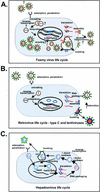Foamy viruses are unconventional retroviruses
- PMID: 9971751
- PMCID: PMC104413
- DOI: 10.1128/JVI.73.3.1747-1755.1999
Foamy viruses are unconventional retroviruses
Figures




References
-
- Achong B G, Mansell W A, Epstein M A, Clifford P. An unusual virus in cultures from a human nasopharyngeal carcinoma. J Natl Cancer Inst. 1971;46:299–307. - PubMed
-
- Ali M, Taylor G P, Pitman R J, Parker D, Rethwilm A, Cheingsongpopov R, Weber J N, Bieniasz P D, Bradley J, McClure M O. No evidence of antibody to human foamy virus in widespread human populations. AIDS Res Hum Retroviruses. 1996;12:1473–1483. - PubMed
Publication types
MeSH terms
Substances
LinkOut - more resources
Full Text Sources
Other Literature Sources

